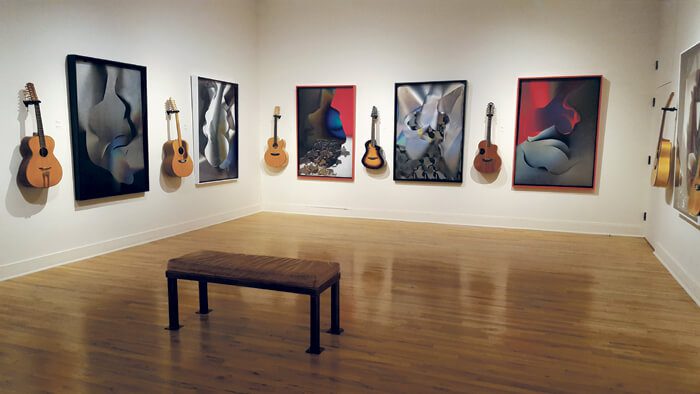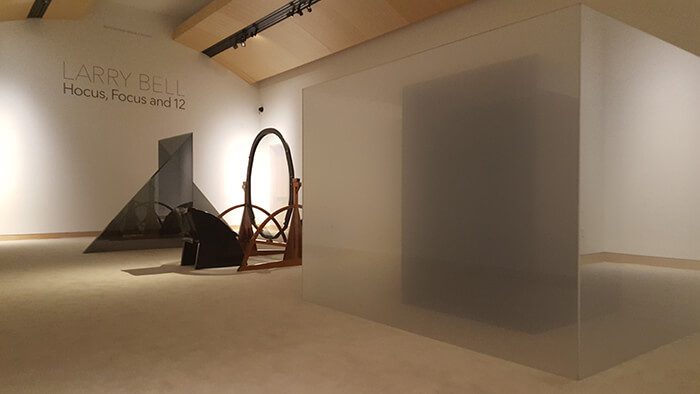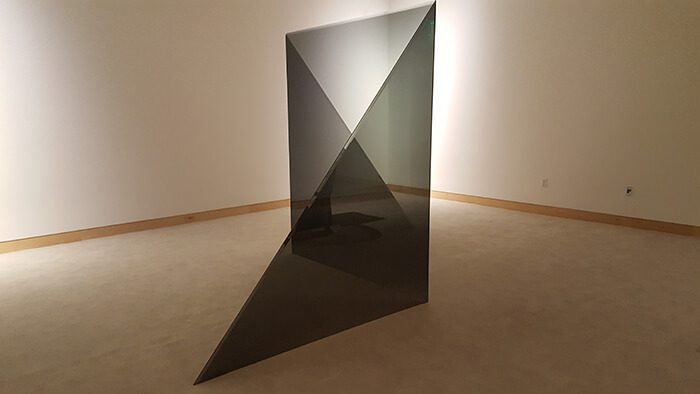
Harwood Museum of Art, Taos
June 9 – October 7, 2018
Larry Bell: Hocus, Focus and 12, currently on view at the Harwood Museum of Art in Taos, is a large-scale exhibition focusing on the artist’s minimalist, architectonic works that reference the clean modernism of Southern California as well as the sleek geometric forms of the 1960s. The exhibition, organized by Gus Foster, Bell’s longtime friend, marks his forty-fifth year of living and working between Taos and Venice, California. Seen as a whole, the exhibition evokes an ethereal quality which, at its best, occupies the atmosphere between public and private spaces.
Bell’s first one-person show was held in 1962 in LA’s Ferus Gallery—a space that showcased the emerging Cool School art movement and exhibited work by Wally Berman, Ed Kienholz, Robert Irwin, Frank Stella, and Andy Warhol. This Los Angeles vibe is always present in Bell’s best works, such as 2017’s Venice Fog, which is prominently displayed at the Harwood after a recent stint in the courtyard of Hauser and Wirth in Los Angeles. The clean lines and subtle gradations of color reference the detachment of post-modern architectural signifiers—hard edges, smooth surfaces, reflective geometric sheets of laminated glass, and a sense that you are viewing a space within a space. They are containers within containers that the artist interprets as “looking at that space, because the reflections of the area line up with it; there’s a mystery as to what’s in there, when in fact there’s nothing.”
The 2018 laminated glass maquettes, lined up in a row of six, move across a vivid color palette of blues, pinks, reds, and whites. Seen as a collection, they evoke musical notes that emerge as synesthetic tonal associations. Viewing the maquettes from left to right and back to left, induces both an ocular play of hues as well as their associated aural tones. Together, these objects engage with each other in a unique multisensory way.
The color sounds of the maquettes are echoed, at least in this viewer’s imagination, in the artist’s collection of twelve-string guitars on display on the museum’s second floor. The twelve instruments, which date from 1910-2017, are hung on the walls and paired with paper works from the mixed media Church Studies series from 2015-2016. These works, named after Bell’s Venice studio, which is a former church, utilize a two-dimensional version of his coating technique, achieving a layered yet luminescent surface quality.

Bell’s Light Knot works, made from mylar-coated aluminum, float above the museum’s stairwell. The three lyrical sculptures from 2012-2013 move gently with the circulating air, creating an aerial triptych, each element with its own visual identity that is distinct from every viewpoint. The constantly shifting and emerging forms echo Bell’s interest in newness; as he says, “I’m addicted to that instant of surprise, where you do something and all of a sudden it becomes something else. It’s a beginning, and I like beginnings.”
The sleight of hand, suggested in the exhibition’s title, is never more evident than in the 2002 work, Time Machine—a vignette which is anchored by a large mirror, salvaged from the Los Alamos Labs surplus yard. The mirror is paired with two armchairs, creating the illusion of presence and absence. The work, a reference to H.G. Wells’s 1895 science fiction novella, is perhaps Bell’s most direct reference to the scientific legacy of Northern New Mexico’s atomic city.
Bell’s work, spanning six decades, retains its significance through his agile use of the reflective coating process, as well as his unique approach to the physicality of the work. As the artist explains, “I liked the fact that the light was reflected back directly to the viewer, leaving a blank and empty space where the construction stood.”




